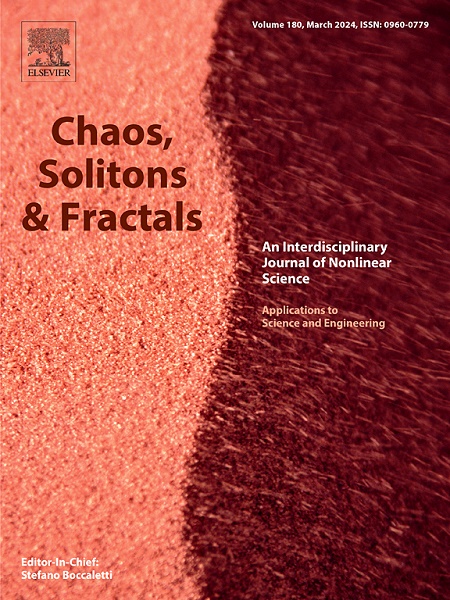分数阶非线性磁感应杂质
IF 5.3
1区 数学
Q1 MATHEMATICS, INTERDISCIPLINARY APPLICATIONS
引用次数: 0
摘要
本文研究了含有单一线性/非线性磁性杂质的一维裂环谐振器阵列,其中通常的离散拉普拉斯算子被分数阶拉普拉斯算子所取代。在不含杂质的情况下,磁感应波的色散关系为封闭形式,带宽随分数指数的减小而减小。其次,利用晶格格林函数,我们得到了束缚态能量及其空间分布,作为杂质强度的函数。我们证明,在较大的杂质强度下,对于线性和非线性杂质情况,束缚态能量与杂质强度成线性关系。平面波的传输是半解析计算的,显示了线性和非线性杂质情况之间的定性相似性。最后,我们计算了从杂质位置的完全初始定域条件演化后系统在杂质位置的剩余磁能量。对于线性和非线性杂质,发现对于固定分数指数,存在磁能捕获,磁能捕获随杂质强度的增加而增加。在一定的磁场强度下,捕获量随分数指数的减小而增加。本文章由计算机程序翻译,如有差异,请以英文原文为准。
The fractional nonlinear magnetoinductive impurity
We study a one-dimensional split-ring resonator array containing a single linear/nonlinear magnetic impurity where the usual discrete Laplacian is replaced by a fractional one. In the absence of the impurity, the dispersion relation for magnetoinductive waves is obtained in closed form, with a bandwidth that decreases with a decrease in the fractional exponent. Next, by using lattice Green functions, we obtain the bound state energy and its spatial profile, as a function of the impurity strength. We demonstrate that, at large impurity strengths, the bound state energy becomes linear with impurity strength for both linear and nonlinear impurity cases. The transmission of plane waves is computed semi-analytical, showing a qualitative similarity between the linear and nonlinear impurity cases. Finally, we compute the amount of magnetic energy remaining at the impurity site after evolving the system from a completely initially localized condition at the impurity site. For both cases, linear and nonlinear impurities, it is found that for a fixed fractional exponent, there is trapping of magnetic energy, which increases with an increase in impurity strength. The trapping increases with a decreased fractional exponent for a fixed magnetic strength.
求助全文
通过发布文献求助,成功后即可免费获取论文全文。
去求助
来源期刊

Chaos Solitons & Fractals
物理-数学跨学科应用
CiteScore
13.20
自引率
10.30%
发文量
1087
审稿时长
9 months
期刊介绍:
Chaos, Solitons & Fractals strives to establish itself as a premier journal in the interdisciplinary realm of Nonlinear Science, Non-equilibrium, and Complex Phenomena. It welcomes submissions covering a broad spectrum of topics within this field, including dynamics, non-equilibrium processes in physics, chemistry, and geophysics, complex matter and networks, mathematical models, computational biology, applications to quantum and mesoscopic phenomena, fluctuations and random processes, self-organization, and social phenomena.
 求助内容:
求助内容: 应助结果提醒方式:
应助结果提醒方式:


